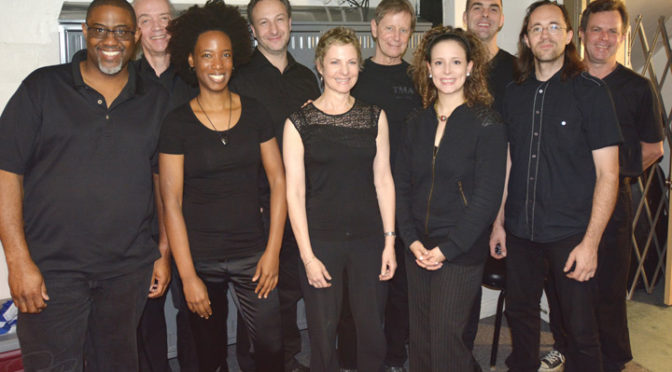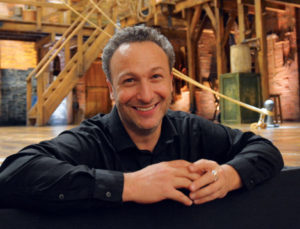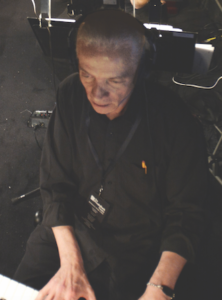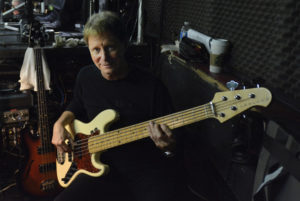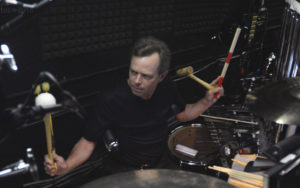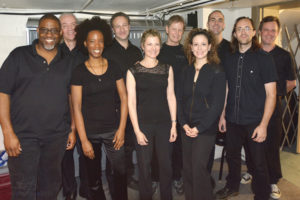
The Chicago Hamilton band, all members of Local 10-208 (L to R): Felton Offard (guitar), Rick Snyder (keyboard 2/assistant conductor), Tahirah Whittington (cello), Colin Welford (music director, conductor, keyboard 1), Roberta Freier (violin 2), Tom Mendel (bass), Heather Boehm (viola/violin), Tom Hipskind (drums), Chuck Bontrager (concert master/violin 1),
and Jim Widlowski (percussion).
Hamilton Chicago opened October 19, while the Broadway show continues its unprecedented success in New York City. Playing a show like Hamilton, likely to enjoy a long run, is a dream come true for its Local 10-208 (Chicago, IL) musicians. These musicians all share a love for playing the wide variety of genres—from rap to classical—that composer Lin-Manuel Miranda and arranger Alex Lacamoire have written into the show. The demanding nature of Hamilton, in terms of stamina and timing, keeps musicians on their toes.
International Musician asked the pit—the six-piece rhythm section of Colin Welford (music director, conductor, keyboard1), Rick Snyder (keyboard 2/assistant conductor), Felton Offard (guitar), Tom Mendel (bass), Tom Hipskind (drums), and Jim Widlowski (percussion), plus string quartet of Chuck Bontrager (concert master/violin 1), Roberta Freier (violin 2), Heather Boehm (viola/violin), and Tahirah Whittington (cello)—to talk about their experiences so far.
Leading the Pit
“It feels so nice going in with confidence,” says Music Director and Conductor Colin Welford, referring to the Broadway show’s success. “You can see that in the cast. We know it’s going to sell very well for a good while. It gives you a feeling
of empowerment.”
“The parts are well written so there is breathing room, listening room; it’s varied. Also, the actors keep it fresh. It’s not going to be cookie cutter by any means. That keeps it alive for us,” he adds.
“The most important thing is for the conductor to bring people in together. There’s quite a lot of that, ” says Welford, explaining his role. “It looks complicated on paper, but it’s really about the conductor listening to the stage and making a decision when to place the chord. It looks fuzzy on paper, but makes for a natural performance. The show isn’t directed to the minuscule detail—first it’s acted, second it’s rhythmic.”
Welford had worked with Assistant Conductor Rick Snyder in both Wicked and The Lion King. “I’d been with The Lion King for about seven and a half years, waiting for an opportunity to go home, but I needed a hit,” says Snyder. When he heard about Welford doing Hamilton Chicago he saw his opportunity.
Snyder was immediately drawn to the music. “When I heard the show—reading the book at the same time—I thought it was an outstanding adaptation. I didn’t know how I would react to the rap, but it’s really smart. Plus, there’s also a whole lot of late ’70s and ’80s pop music underneath, and that’s what I was weaned on,” he says.
Both conductor/keyboardists say that the fact that the show is extremely verbal means that actors and musicians must be keenly focused. “It’s a challenge for the actors as they’ve got to shape the phrases and communicate [through singing] as in normal conversation, so that the offset of the rhythm doesn’t throw the ear in such a way that the listener gets confused,” says Welford.
Driving Rhythm
Bassist Tom Mendel plays four instruments in the show. “I’m playing acoustic bass, five-string electric, four-string hollow body for a ‘Paul McCartney’ kind of sound, and keyboard bass, which is pretty unusual. There’s one tune where I’m playing gliss on the five-string bass, and then on the next downbeat, keyboard bass,” he says.
“Alex’s arrangements are very specific and rewarding. He understands the instruments he’s writing for,” he adds. “There is so much nuance in the part, yet still room for putting individual ‘feel’ into it. I really want to honor his arrangements and Lin’s amazing songs. It demands complete concentration for both acts—an hour and 15 minutes each.”
“When Hamilton was at the Public Theatre, everyone would ask, ‘Is it really that good?’ Yes, it is!” says guitarist Felton Offard, explaining what drew him to the show. “Alex Lacamoire’s orchestration calls on each instrument to create colors that put us in a certain time and place. The diversity was what I loved so much. It goes from classical string quartet to all out rock and roll—sometimes in the same song.”
“I’ve never played a through-composed show before—one that doesn’t have any time to rest. This show is a beast for every chair. The electric guitar has 131 patch changes,” he says. “There’s an articulation mark for almost every note.”
For drummer Tom Hipskind, it was the special kinship he felt playing the Miranda/Lacamoire show In the Heights that made him want to play Hamilton. He wasn’t disappointed.
“The lyrics are so catchy and well written,” he says, pointing to the “sheer constancy” of the show. “Most shows have their moments of ebb and flow, but Hamilton has a relentless drive from beginning to end that is reflected in every aspect: music, choreography, lighting. To be part of that, much less to be driving that freight train as the drummer, is quite the rush! Rhythmic demands are what I live for as a drummer, and when I have an amazing part like this to play, it comes naturally and feeds me creatively!”
The Strings
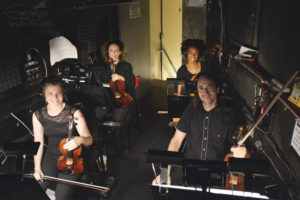
(L to R) The strings (front) Roberta Freier and Chuck Bontrager (back) Heather Boehm, and Tahirah Whittington.
Chuck Bontrager, concertmaster and violin 1, says that words cannot express how fortunate and grateful he feels to be part of Hamilton. “Ever since I started college, nonclassical styles have been as important to me as Beethoven and Shostakovich. In Hamilton, I get to use my Mozart chops, help with rock riffs, carry ballads, and play Motown-like pad and lead lines,” he says.
Bontrager says it’s the most stylistically diverse and challenging show for bowed strings that he’s seen. “There are many sections throughout the show where parts of the string quartet carry the groove. That’s very unusual and brave writing. I think it will prove to be some of the most important and influential string writing in any arena in the past several decades.”
Violinist Roberta Freier says that style, rhythm, and intonation are the most challenging aspects of playing Hamilton. “Other shows I’ve played are more ‘symphonic’ in nature. Your notes can ring and the rhythms are less complex. In Hamilton, pizzicatos are dampened and most notes are very short,” she explains, adding that it was the idea of combining old and new genres that drew her to the show.
“I’m a classically-trained musician who grew up having an affinity for R&B, hip-hop, classical, and soul,” says cellist Tahirah Whittington. “Having the opportunity to perform in Hamilton is living the dream. The way in which Hamilton mashes up different time periods and idioms is mirrored in the score. It’s the ultimate collaboration of time, text, and music.”
“The cello plays many different roles in the show,” she says. Whittington plays solo, rhythm section, bass voice of the string quartet, tenor voice of the string quartet, as a duo with other instruments, plus is the rhythmic drive in songs like “We Know.” “The music never stops for ‘in the clear’ dialogue,” she adds.
“I don’t know if this is a one-off show,” concludes Welford. “It really requires very good timing and I think that’s definitely something we’ll see more of in the future, whether it’s hip-hop or rap. But it’s important to note that, though we talk about the show as rap or hip-hop, it’s still solidly based in musical theatre with so many styles on stage and so many roots. It’s not this weird, bizarre thing. It’s smart, with homage to a lot of musical theatre traditions as well.”


